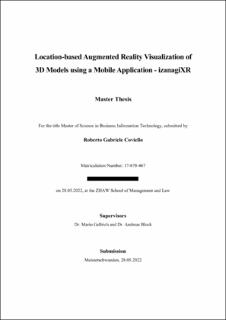Please use this identifier to cite or link to this item:
https://doi.org/10.21256/zhaw-27106Full metadata record
| DC Field | Value | Language |
|---|---|---|
| dc.contributor.advisor | Gellrich, Mario | - |
| dc.contributor.advisor | Block, Andreas | - |
| dc.contributor.author | Coviello, Roberto Gabriele | - |
| dc.date.accessioned | 2023-02-23T16:30:57Z | - |
| dc.date.available | 2023-02-23T16:30:57Z | - |
| dc.date.issued | 2022 | - |
| dc.identifier.uri | https://digitalcollection.zhaw.ch/handle/11475/27106 | - |
| dc.description.abstract | Introduction: The increasing use of AR in practical applications such as education, design, manufacturing, and construction shows enormous promise for upgrading existing technology and improving quality of life. Meanwhile, the construction industry is well known for falling behind in the implementation of IT even though the digitalization is already transforming the industry across the entire lifecycle. A peculiarity in Switzerland is that in most cantons, projects still must be marked with physical metal poles called construction spans. Methodology: The aim of this research is to investigate an effective method for visualizing 3D models using location-based Augmented Reality. This paper seeks to identify the necessary steps for developing an application to accurately visualize 3D buildings using location-based AR for replacing construction spans and to find out what the benefits and challenges are. For this purpose, an AR artifact is being developed and five interviews with industry experts are being conducted to gain a better understanding of the current practice. Findings: The costs of erecting and maintaining such construction spans can amount to 0.1% or more of each construction project depending on its height and the complexity of the terrain. AR represents an enabling technology for customer engagement. It can be reasoned that by externalizing the visualization of construction projects, AR can reduce the mental effort customers need to participate in a productive discourse. AR technology has been improving dramatically and together with hybrid localization methods it is able to display information accurately and reliably in the physical world. Recommendations: In light of the findings of this research, developers, and public bodies such as municipalities alike should evaluate the use of AR applications for replacing construction spans and digitize the construction span industry to save significant investment amounts and opportunity losses. This paper recommends the above-mentioned stakeholders to explore the potential of AR applications additionally to using construction spans to gain important experience and to get an idea how their industry could look like once construction spans are not legally required anymore and AR hardware has overcome current limitations. | de_CH |
| dc.format.extent | 111 | de_CH |
| dc.language.iso | en | de_CH |
| dc.publisher | ZHAW Zürcher Hochschule für Angewandte Wissenschaften | de_CH |
| dc.rights | http://creativecommons.org/licenses/by-nc-nd/4.0/ | de_CH |
| dc.subject.ddc | 006: Spezielle Computerverfahren | de_CH |
| dc.title | Location-based augmented reality visualization of 3D models using a mobile application – izanagiXR | de_CH |
| dc.type | Thesis: Master | de_CH |
| dcterms.type | Text | de_CH |
| zhaw.departement | School of Management and Law | de_CH |
| zhaw.publisher.place | Winterthur | de_CH |
| dc.identifier.doi | 10.21256/zhaw-27106 | - |
| zhaw.originated.zhaw | Yes | de_CH |
| Appears in collections: | MSc Wirtschaftsinformatik | |
Files in This Item:
| File | Description | Size | Format | |
|---|---|---|---|---|
| 2022_Roberto_Gabriele_Coviello_MSc_WI.pdf | 3.06 MB | Adobe PDF |  View/Open |
Show simple item record
Coviello, R. G. (2022). Location-based augmented reality visualization of 3D models using a mobile application – izanagiXR [Master’s thesis, ZHAW Zürcher Hochschule für Angewandte Wissenschaften]. https://doi.org/10.21256/zhaw-27106
Coviello, R.G. (2022) Location-based augmented reality visualization of 3D models using a mobile application – izanagiXR. Master’s thesis. ZHAW Zürcher Hochschule für Angewandte Wissenschaften. Available at: https://doi.org/10.21256/zhaw-27106.
R. G. Coviello, “Location-based augmented reality visualization of 3D models using a mobile application – izanagiXR,” Master’s thesis, ZHAW Zürcher Hochschule für Angewandte Wissenschaften, Winterthur, 2022. doi: 10.21256/zhaw-27106.
COVIELLO, Roberto Gabriele, 2022. Location-based augmented reality visualization of 3D models using a mobile application – izanagiXR. Master’s thesis. Winterthur: ZHAW Zürcher Hochschule für Angewandte Wissenschaften
Coviello, Roberto Gabriele. 2022. “Location-Based Augmented Reality Visualization of 3D Models Using a Mobile Application – izanagiXR.” Master’s thesis, Winterthur: ZHAW Zürcher Hochschule für Angewandte Wissenschaften. https://doi.org/10.21256/zhaw-27106.
Coviello, Roberto Gabriele. Location-Based Augmented Reality Visualization of 3D Models Using a Mobile Application – izanagiXR. ZHAW Zürcher Hochschule für Angewandte Wissenschaften, 2022, https://doi.org/10.21256/zhaw-27106.
Items in DSpace are protected by copyright, with all rights reserved, unless otherwise indicated.